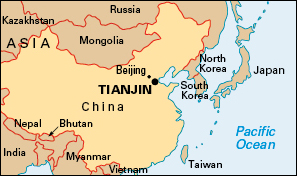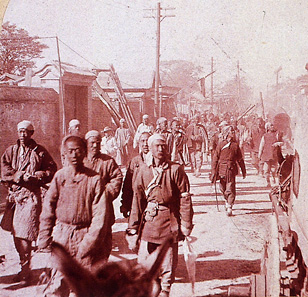Tianjin, << tyehn jihn >> (pop. 10,900,000), is an important trading center in northern China. Its name was formerly spelled Tientsin or T’ien-chin. Tianjin lies near the mouth of the Hai River, about 85 miles (137 kilometers) southeast of Beijing.

Tianjin and its suburbs form one of China’s four municipalities that are ruled directly by the national government. These four metropolitan areas have a political status similar to that of a province. The others are Beijing, Chongqing, and Shanghai. The Tianjin special municipality covers about 4,360 square miles (11,300 square kilometers) and has about 15 million residents.
Railroads connect Tianjin with Beijing, Nanjing, Shanghai, and the cities of the Northeast (sometimes called Manchuria). Tianjin has an airport that offers flights to most other cities in China. Tianjin serves as the chief port for the Beijing area.
Tianjin is one of China’s leading manufacturing areas. Goods produced in the region include iron and steel, textiles, processed foods, and industrial products. Offshore oil fields make Tianjin an important center for petrochemical products. Tianjin has a large number of universities and technical schools.
After the Sui dynasty (A.D. 581-618) expanded the Grand Canal north to Tianjin, the city began to serve as an important port for goods traveling between north and south China. In the early 1400’s, the Ming dynasty constructed fortified walls around the city.
In 1860, Western nations forced China to open Tianjin and its port to foreign trade. Eight countries established concessions in Tianjin. Concessions were tracts of land in the city on which the foreign powers built settlements and forts and over which they exercised control. See China (Clash with the Western powers).

Fighting between Japan and China in 1937 badly damaged Tianjin. Japan seized the city and held it until the end of World War II in 1945. The last foreign concession in Tianjin returned to Chinese control in 1946.
In 1976, an earthquake struck Tianjin, Tangshan, Beijing, and surrounding areas. About 240,000 people died, mostly in Tangshan, and some estimates run as high as 655,000 people. In August 2015, a warehouse storing toxic chemicals caught fire and exploded near Tianjin’s port, killing at least 173 people.
See also Grand Canal.
